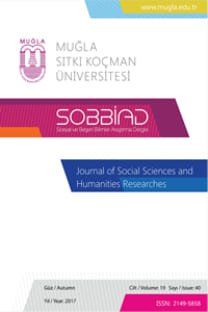Sınır Bölgelerinde Yılan Tanrıçalarını Serbest Bırakmak: Cherrie Moraga’nın The Hungry Woman: A Mexican Medea Oyunundaki Feminist Yapı
Cherrie Moraga’nın The Hungry Woman: A Mexican Medea adlı tiyatro oyunu başkarakter Medea’nın başka bir kadınla olan aşk ilişkisi sebebiyle vatanı Aztlán’dan sürüldüğü bir gelecek distopyasında geçmektedir. Medea, kız arkadaşı, oğlu ve annesi ile birlikte Aztlán’ın ataerkil otoriteleri tarafından istenmeyen insanların oluşturduğu bir çorak arazi olan Phoenix’de yaşamaktadır. Oğlunun yozlaşmış ataerkil bireylerle yaşamak için Aztlán’a geri dönmesini önlemek ve böylelikle masumiyetini korumak için Medea oğlunu öldürür ve sürekli olarak çocuğunu öldürmenin hatırası ile işkence çektiği bir akıl hastanesi odasına hapsedilir. Euripides’in Medea’sının bu yeniden yorumlanmasında, Moraga eşcinsel öznelerin dışlanması konusunu irdelemek için bazı mitik, folklorik ve edebi kadın figürlerine değinir. Bu figürler arasında, çağdaş Chicana feminizmindeki kadın bilincinin sorgulamak için başlıca kültürel semboller olarak yeniden ortaya çıkarılan Cihuatateo ve Coatlicue bulunmaktadır. Bu çalışma Moraga’nın bu arketip tanrıçaları nasıl yeniden sahiplendiğini ve kavradığını Chicana yerli feminizmi bağlamında incelemektedir.
Anahtar Kelimeler:
Cherrie Moraga, The Hungry Woman: A Mexican Medea, Chicana feminizmi
Liberating Serpentine Goddesses on the Borderlands: Cherrie Moraga’s Feminist Architecture in The Hungry Woman: A Mexican Medea
Cherrie Moraga’s The Hungry Woman: A Mexican Medea takes place in a future dystopia in which the protagonist Medea is exiled from her homeland Aztlán due to her love affair with another woman. She lives with her girlfriend, son and mother in Phoenix—a wasteland populated by the people unwanted by the patriarchal authorities of Aztlán. In order to prevent her son’s attempt to get back to Aztlán to live with the corrupted patriarchs and thereby to protect his purity, Medea kills her son and is sent to a prison psychiatric ward tormented by the memory of her infanticide. In this reinterpretation of Euripides’ Medea, Moraga refers to several mythical, folkloric and literary female figures to touch upon the exclusion of the queer subject. Among them, there are female deities such as Cihuatateo and Coatlicue that have been recuperated as prominent cultural symbols to question the female consciousness in contemporary Chicana feminism. This paper examines how Moraga reappropriates and discerns these archetypal goddesses in the context of Chicana indigenous feminism.
___
- Alarcón, N. (1990), “Chicana Feminism: In the Tracks of ‘the’ Native Woman”, Cultural Studies, Vol: 4 No: 3, pp. 248-256.
- Anzaldúa, G. (1987), Borderlands/La Frontera: the New Mestiza, Aunt Lute Books, San Francisco.
- Arredondo, G. F., et al., eds. (2003), Chicana Feminisms, Duke University Press, Durham.
- Costa-Malcolm, J. A. (2013). Virgin and Whore no more. Reinventions of the Mythical Maternal in Chicana Drama (Unpublished Doctoral Dissertation), University of Pittsburgh.
- Cotera, M. P. (1977), The Chicana Feminist, Information Systems Development, Austin.
- Franco, J. (2004), “The Return of Coatlicue: Mexican Nationalism and the Aztec Past”, Journal of Latin American Cultural Studies, Vol:13, No:2, pp. 205-219.
- Garcia, A. M. (1997), “Introduction”, Garcia Alma M. and Garcia Mario T. (Eds.) Chicana Feminist Thought: The Basic Historical Writings, Routledge, New York, pp. 1-16.
- Quinn-Sánchez, K. (2015). “Rejecting National Mores/ There is no Country for Lesbian Latinas,” Identity in Latin American and Latina Literature: The Struggle to Self, Lanhan, Lexington Books, pp. 35-45.
- Lakey. (2015), “More than Theater: Cherrie Moraga’s The Hungry Woman and the Feminist Phenomenology of Excess”, Robin Truth Goodman (Ed.),Literature and Development of Feminist Theory, Cambridge, New York, pp. 200-213.
- Lomeli, F. A. (2017), “Introduction: Revisiting the Vision of Aztlán: Origins, Interpretions, and Theory vis-à-vis Fact and Fiction”, Rudolfa Anaya et al (Eds.), Aztlán: Essays on the Chicano Homeland, University of Mexico Press, Albuquerque, pp 1-24.
- Mirandé, A, Enríquez, E. (1979), La Chicana: The Mexican-American Woman, The Universtiy of Chicago Press, Chicago.
- Moya P. M. L. (2001), “Chicana Feminism and Postmodernist Theory”, Signs, Vol: 26, No:2, pp. 441-483.
- Moraga, C. (1993) The Last Generation, South End Press, Boston.--- (2000), “The Hungry Woman: A Mexican Medea”, Marrero, Maria and Svich, Caridad (Eds.), Out of the Fringe: Latino/a Theater and Performance, Theater Communications, New York, pp. 289-363.
- Oliver-Rotger, M. A. (2003). “The Border as Dystopia: Cherrie Moraga’s The Hungry Woman”, Battlegrounds and Crossroads Social: Social and Imaginary in Writings by Chicanas, Rodopi, Amsterdam, pp. 265-284.
- Perez, D. R. (2008), There was a Woman: La Llorona from Folklore to Popular Culture. University of Texas Press, Austin.
- Ventura, G. B. (2008), “Aztlán”, Nicholás Kanellos (Ed.), The Greenwood Encyclopedia of Latino Literature, Greenwood Press, Westport, pp.102-104.
- ISSN: 2149-5858
- Yayın Aralığı: Yılda 2 Sayı
- Başlangıç: 2000
- Yayıncı: Mugla Sitki Kocman University
Sayıdaki Diğer Makaleler
Kadınların Tüketim Alışkanlıklarının Kuşaklararası Boyutu
Funda BAYRAKDAROĞLU, Çağlar ÖZBEK
Kadınlarda Finansal Eğitimin Finansal Okur-Yazarlık Üzerindeki Etkisine Yönelik Bir Araştırma
Ali BAYRAKDAROĞLU, Serenay BİLGE
Feminist Teori Işığında Muğla Masallarında Kadın Algısı
Kavramsal Sanatın Öncüsü Marcel Duchamp’ın Çalışmalarında Kadın İmgesi
Türkiye'nin İlk Türk Kadın Doktoru: Safiye Ali ve Çalışmaları
Hak, Cinayet Ve Politika Üçgeninde Kürtaj Hakkı
Türkiye'nin İlk Türk Kadın Doktoru: Safiye Ali ve Çalışmaları
Klasik Dönem (MÖ 500-300) Halikarnassos Kentinde Hanedanlık ve Kadın Yöneticiler
